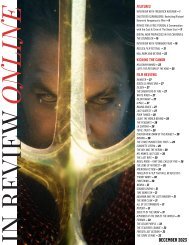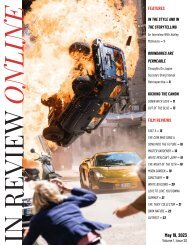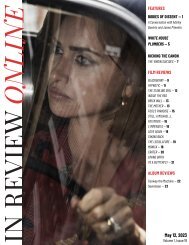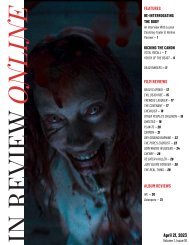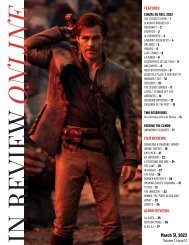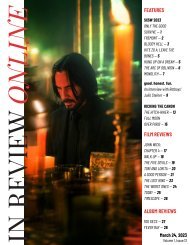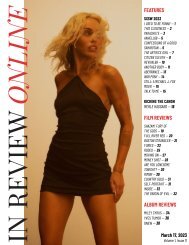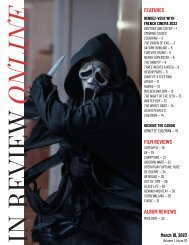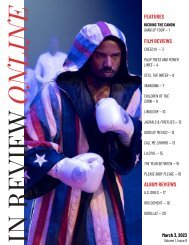InRO Weekly — Volume 1, Issue 7
You also want an ePaper? Increase the reach of your titles
YUMPU automatically turns print PDFs into web optimized ePapers that Google loves.
MORALITY, MURDER, & MISANTHROPIC<br />
MILIEUS IN BULLY AND O<br />
In the summer<br />
of 2001, Lionsgate distributed<br />
two brutal films about young adults<br />
carrying out murderous conspiracy plots<br />
against their friends. The first, Larry Clark’s<br />
Bully, premiered at the performance-focused<br />
Method Fest in mid-June before its U.S.<br />
theatrical distribution the following month;<br />
and late August saw the release of Tim Blake<br />
Nelson’s O (Othello), which followed a recent<br />
cycle of Shakespeare adaptations reimagined<br />
for contemporary young adult milieus<br />
(Romeo + Juliet [1996], 10 Things I Hate About<br />
You [1999], Get Over It! [2001], etc.) Although<br />
Larry Clark’s singularly vicious vision differs<br />
significantly from Nelson’s more conventional<br />
directorial style, these back-to-back releases<br />
exhibit fascinating thematic and tonal<br />
convergences, most specifically in terms of<br />
their shared moral complexity.<br />
1
The films’ mutual resonances gesture to a burgeoning sense of<br />
pessimism in America at the turn of the century, the cumulative<br />
consequence of environmental disaster, reactionary politics,<br />
racial tensions, and national and military violence. Consider, for<br />
example, Richard Baumhammer’s racially-motivated mass<br />
murder in 2000; the ecologically catastrophic Martin County coal<br />
slurry spill the same year; and the election of far-right George W.<br />
Bush as U.S. president in January 2001. Bully and O were also<br />
released two years after the Columbine High School massacre of<br />
1999, which spurred several major studios to delay, cancel, or<br />
significantly rework any films depicting young adult violence. O<br />
was itself originally scheduled for release in 1999 but was<br />
ultimately delayed after Columbine High’s Eric Harris and Dylan<br />
Klebold murdered twelve of their classmates and one of their<br />
teachers.
films share this central conceit of murder plots enacted by young<br />
adults, though the target in Bully is staged as a substantially less<br />
“innocent” character than Odin. As in O, though, the murder target<br />
grapples with his own conflicted masculinity, and with his<br />
father’s domineering and subtly sinister presence.<br />
Both Larry Clark’s Bully and Tim Blake Nelson’s O mine their grim<br />
stories for nuanced and complex dealings with group morality.<br />
The films’ central acts of violence are dislocated from single<br />
guilty parties, arising instead from stews of personal, familial,<br />
and social factors. O’s Hugo acts as the film’s devious narrative<br />
architect: he manipulates others to join his plot to exterminate<br />
Odin, whom he perceives as the ultimate threat to his<br />
masculinity. Bully finds its own Shakespearean plotter in the<br />
scheming orchestrator of death, Lisa (Rachel Miner), a<br />
contemporary approximation of Lady Macbeth <strong>—</strong> it is no<br />
coincidence that, after her friend group viciously butchers Bobby<br />
in a remote glade, she frantically insists that she can still smell<br />
the young man’s blood, even despite her accomplices’ assurances<br />
to the contrary.<br />
Clark and Nelson’s films parse their engagements with guilt by<br />
drawing subtly on their sociopolitical milieus <strong>—</strong> interestingly, Gus<br />
Van Sant’s 2003 minimalist high school shooting drama Elephant<br />
explores related ideas to similar effect. Bully and O are awash in<br />
contemporary cultural signifiers, soundtracked by ‘90s and ‘00s<br />
hip-hop, prickly with the recent Columbine massacre’s<br />
implications of rage-filled, adolescent male disenfranchisement.<br />
O’s wealthy, white, handsome Hugo is suffocated by the<br />
imposition of his father and school’s rigid class and gender<br />
expectations (bound up in subtle and not-so-subtle forms of<br />
racism); and Bully’s largely uneducated, hopeless youths drift<br />
hazily through an environment typified by drug dependency,<br />
existential purposelessness, and casual misogyny.<br />
Indeed, these films are brutally confrontational in their portrayals<br />
of socialized sexism: in a red haze of jealousy, O’s Odin rapes his<br />
girlfriend Desi (Julia Stiles); Bully’s Bobby exorcises his repressed<br />
queerness by sexually humiliating and trafficking several friends,<br />
including his best buddy Marty, and by raping his on-and-off<br />
lover Ali (Bijou Phillips) while forcing her to view gay<br />
“These films’ visual particularities supplement their overarching visions of<br />
doomed American adolescence. To watch Bully and O is to experience the<br />
bleakest of turn-of-the-century, young adult American cinema.<br />
In both films, Manichean moral systems falter. Neither Hugo nor<br />
Lisa represents a one-note cipher of evil. Instead, Bully and O<br />
grant their dark Shakespearean puppeteers with human pathos<br />
<strong>—</strong> Clark’s film emphasizes the intensification of Rachel’s<br />
insecurity and low self-esteem under her boyfriend Marty’s (Brad<br />
Renfro) abusive and dismissive behavior, and O locates Hugo’s<br />
quiet pain in the presence of his belittling, emasculating father<br />
and coach, Duke (Martin Sheen). Bully and O further emphasize<br />
their respective diffusions of guilt through the structures of<br />
ensemble drama <strong>—</strong> Bully’s drug-hazed group collectively (and<br />
haphazardly) plans and executes the murder of Bobby, while O’s<br />
Hugo depends heavily on sycophantic classmate Roger (Elden<br />
Henson) to set the stage for his nefarious scheme.<br />
pornography. In O, Desi minimizes her own experience as a<br />
victim; in Bully, Lisa laughs aside her friend Ali’s trauma. Lisa’s<br />
moral murkiness connects to her more generalized state of<br />
tragic denial, flippantly proposing the murder of Bobby Kent and<br />
daydreaming about the possibility of sharing a child with Marty,<br />
even despite his abusive response to her pregnancy. O’s own<br />
complicated “villain,” Hugo, devotes his entire sense of self-worth<br />
to the masculine spectacle of high school basketball games,<br />
injecting HGH, and forming malicious schemes off-court to fill his<br />
psychopathic void of self-comprehension.<br />
Certainly, these films share a fundamental interest in the moral<br />
quagmire endemic to their contemporary America. Larry Clark<br />
3
affords his sweaty, lusty, Florida-set film with the kind of textual immersion and brutal verisimilitude that permeates his entire<br />
preceding oeuvre (from his stunningly brazen debut photography collection, Tulsa [1971], to his harrowing, Cassavetes-esque film<br />
debut, Kids [1995], to his texturally vivid crime-drama Another Day in Paradise [1998]). Bully is a film centered on images, befitting an<br />
auteur whose cinematic expression is steeped in his experience as a photographer: Clak exhibits a pruriently eager obsession with<br />
his cast’s bodies and sexualities, and he places pictorial emphasis on their milieus <strong>—</strong> Bully is sticky-hot with the texture of beaches,<br />
middle-class domiciles, video game arcades, and humid Florida streets. Though O does not reach Bully’s level of bold aesthetic<br />
sophistication, it does deliberately relegate most of its drama to the basketball courts and residences of its high-class prep school,<br />
stressing Odin’s visible racial marginalization within the almost ubiquitously wealthy whiteness of its student population.<br />
These films’ visual particularities supplement their overarching visions of doomed American adolescence. To watch Bully and O is to<br />
experience the bleakest of turn-of-the-century, young adult American cinema. The pictures are exemplary in their brutal honesty,<br />
ethical opacity, and pessimism. And while their dramas are distinctly intimate, Bully and O transcend the notion of a narrow scope,<br />
gesturing to far larger cultural anxieties and crises. <strong>—</strong> MIKE THORN<br />
4
AN ODE TO<br />
DECADENCE<br />
An Interview<br />
With Albert Serra<br />
Despite boasting a<br />
filmography mostly known for its<br />
unorthodox approximations to period detail<br />
and the formal subversions that come with<br />
it, the defining characteristic of Albert<br />
Serra’s fiction oeuvre might be its subtler<br />
Thematic undercurrents around the anxiety<br />
of insignificance. Since the bumbling buffoons<br />
of Don Quixote and Sancho Panza struggling to cope<br />
with the death of chivalry in Honour of the Knights (2006),<br />
Serra’s feature-length works have traversed different<br />
approximations to the innate tension of seeing all of one’s<br />
values and convictions crumble in real time, finding a<br />
particular fascination in the sordid details<br />
that arise within these decaying<br />
environments.<br />
5
Pacifiction sees Serra return to many of these recurring<br />
concerns, but from a refreshed perspective, one less interested<br />
in conceptual extravagance and provocation than in playing with<br />
the medium’s possibilities and taking them to their utmost limits.<br />
In this conversation, the Catalan filmmaker talks through his<br />
stylistic evolution, the challenge of fabricating icons for a<br />
contemporary setting, and the possibilities that come with sonic<br />
exploration.<br />
Since the release of Liberté in 2019, you’ve talked about<br />
growing tired of historic depictions, and wanting to establish<br />
some kind of dialogue with the contemporary world. Did any<br />
creative challenges arise while making this contextual<br />
switch in Pacifiction?<br />
For me, the change wasn’t just about wanting to explore<br />
something for my own artistic reasons, more so than it’s also an<br />
inherent part of the world. In my historic works, I now feel there’s<br />
a sense of artificiality; these worlds feel a bit staged to me. Just<br />
by working with performers, the fact that you’re doing an historic<br />
fiction gives them some sense of grounding in certain<br />
iconographies. You don’t really have to create anything. With the<br />
contemporary, you have to create something with no timely<br />
referents; you’re constructing in real time, basically.<br />
“Americans tend to like the<br />
optimism behind new worlds<br />
and their discovery, while we<br />
Europeans seem fixated on<br />
what’s disappearing around us.<br />
Also, a film as conceptual as Liberté really doesn’t work in a<br />
contemporary context <strong>—</strong> it needs the safety net and background<br />
of historicity to avoid being pure abstraction. So I really wanted<br />
to engage with a more narrative approach, to really go into a<br />
sense of adventure that allows for other kinds of observations. I<br />
took a lot from Stendhal, actually. It wasn’t a thing about having a<br />
thesis on colonialism, nuclear war, or corruption. I feel that<br />
without a political agenda, the film could exist more freely. That’s<br />
why it essentially combines a more objective mise-en-scène,<br />
with a very subjective point of view. It helps make everything<br />
more diffuse and enhance the feel of disorientation.<br />
In your previous works, you did play a lot with the value of<br />
icons, essentially subverting their canonical depictions <strong>—</strong><br />
Casanova and Dracula in Història de la meva mort, Don<br />
Quixote in Honor de Cavallería, The Three Wise Kings in El<br />
cant dels ocells. How was the process of creating De Roller to<br />
be your contemporary icon?<br />
A lot came from working with the actors. Benoît Magimel already<br />
boasts a pretty iconic face, with lots of ambiguity and a sense of<br />
ruggedness to it. Then ideas came during the shooting. Things as<br />
essential as De Roller’s tacky sunglasses were pretty much<br />
Magimel’s initiative, and they perfectly embody what I wanted for<br />
the character. You really can’t read his reactions or what he’s<br />
thinking about. I also told Benoît to wear the white suit at all<br />
times, so it became like a second skin to him.<br />
In a way, since I don’t really read the script with my actors or<br />
anything, De Roller came to be an almost hyperrealistic<br />
performance from Magimel, building the character in real time<br />
while he was on screen. Every decision seemed to double-down<br />
on his grotesque aura, like, for example, showing his tattoo. As<br />
soon as you see that, you ask yourself what kind of people you’re<br />
actually dealing with.<br />
In the film, De Roller does feel like the anchor that holds<br />
together a collapsing vessel, which is the world around him.<br />
Despite not having the inherent meaning projected into your<br />
previous narrative works due to their historic setting,<br />
Pacifiction also feels like those last moments before<br />
inevitable change. What’s your relationship with this<br />
apocalyptic idea around “the end of times”?<br />
I love it, since the end of a period always means the death of<br />
something, and the rise of another. It’s inherently<br />
cinematographic, as there’s a natural tension palpable in the<br />
environment. You’re right, all my films can be described as some<br />
sort of portrait of an agonizing and decaying world that’s about<br />
to end. The out-of-place Libertines, Louis XIV’s death: For them, a<br />
world was ending, and then a new one immediately began.<br />
6
Jean Douchet, a famous French critic, once said my films aren’t<br />
about the drama of actions, but the drama of presence. When I<br />
played with these iconic figures you mentioned earlier, the mere<br />
fact they’re depicted on screen creates some sort of tension,<br />
and a natural narrative immediately arises. Those twilight<br />
moments in history are also very textured and rich, and I enjoy<br />
creating these baroque depictions where you can see them<br />
decomposing in every corner. In Pacifiction, the colonial setting<br />
helps amplify these tensions. It erases the nuances of a place<br />
like Europe, where we have bourgeois middle classes and all<br />
kinds of distinctions, while there, you can’t escape the duality<br />
of colonizers and the indigenous population.<br />
Americans tend to like the optimism behind new worlds and their<br />
discovery, while we Europeans seem fixated on what’s<br />
disappearing around us, and have a weird fascination with what<br />
came before us. We’re perpetually living the end of something, I<br />
feel.<br />
You’ve also mentioned previously the influence of ‘70s<br />
American filmmaking, which stands perhaps in a middle<br />
ground from these two sides you mention; having a sordid<br />
feel for beauty underneath their bleak and doom-laden<br />
surfaces. Do you feel that’s also the case with Pacifiction?<br />
Yes, it’s a weirdly hopeful film for me. It has important flashes of<br />
hope, with the abstracted romance between Shona and De Roller,<br />
for example. If the film didn’t have that, perhaps it’d be too<br />
asphyxiating and conceptual, and I had already done Liberté for<br />
that.<br />
Humor is also an important aspect of this. I like how it<br />
disorientates the viewer and puts the images on screen into<br />
question. The viewers have to ask themselves what kind of film<br />
they’re actually watching, with all the ugly sides of a colonial<br />
setting, and also the moments of absurdity that come from this<br />
world’s contradictions and constant chaos. It’s a very unstable<br />
film, which is something I feel sets it apart.<br />
7
Your way of exalting these aspects of Tahiti seems very deliberate as well, particularly its sonic atmospheres, where<br />
naturalistic and artificial textures work together to create an aura of constant paranoia. How was the process of conceiving<br />
Pacifiction’s aural universe?<br />
From the get-go, we wanted to avoid playing with an overly folkloric soundtrack. That, to me, is very boring and cliché. We did use<br />
some Tahitian and Hawaiian recordings from the 1950s, but put them on their head by mixing them with other sounds. That’s the weird<br />
music you listen to in the nightclub, for example. We wanted to keep destroying those sounds, and that’s where the music evolves into<br />
the dissonant soundscapes that basically drown out everything else and become very oppressive.<br />
I got inspiration from Ennio Morricone’s work on some forgotten horror soundtracks from his day in Italy, and how Jean-Luc Godard<br />
used to approach sound as a layer detached from his films’ visuals. For me, it's an obsession. I want sound to have a relationship with<br />
images, but also be able to give you additional information, and even contradict what images tell you.<br />
Does that also relate to an idea you’ve touched upon earlier in your career about the “aristocracy of images” being fully<br />
independent entities almost?<br />
It’s all about images having their own sovereignty. Images need to be autonomous and self-sufficient. They don’t bow down to anyone.<br />
Sovereign images are very irritating, because they don’t respect you as a viewer. They impose themselves and then mock you.<br />
Sovereign images go beyond social or political leanings, and are much purer, almost amoral. For me, cinema is about these unjust<br />
images, the ones you almost have to make an active effort to endure. <strong>—</strong> INTERVIEW CONDUCTED BY ALONSO AGUILAR<br />
8
KICKING THE CANON<br />
LOCAL<br />
HERO<br />
Bill Forsyth<br />
Bill Forsyth may have to bear the reductive, buzzy distinction of<br />
having “put Scottish cinema on the map,” but he at least did so<br />
with both a disarming degree of separation <strong>—</strong> shifting the<br />
sensation of discovery onto his characters <strong>—</strong> and an expectedly<br />
warm familiarity. Originally an aspiring writer, Forsyth prioritizes<br />
novelistic detail over momentum, which allows him to poke fun at<br />
his country while also reveling in its low-key uniqueness, juggling<br />
breaks in perspective like they were the most graceful of chapter<br />
or paragraph breaks.<br />
Local Hero (1983), only Forsyth’s third feature film, is a<br />
crystallized, just barely diaphanous collection of his gestural<br />
strengths, the narrative hitting pockets of great poignancy and<br />
astuteness, its ambling gait unlocking the significance of all the<br />
circumstantial happenstance (that’s daubed upon the narrative)<br />
as respective grace notes. With a subtle environmentalism<br />
undergirding the film, Forsyth renders human relationships<br />
inextricable from the natural world: A Texas oil man, MacIntyre<br />
(Peter Riegert), is sent off to the fictional coastal town of<br />
Ferness, Scotland, by his batty, star-gazing boss, Felix Happer<br />
(Burt Lancaster), to convince the local populace to allow their<br />
land to be purchased and repurposed as a refinery. MacIntyre<br />
expects to meet resistance, but the townspeople actually<br />
welcome the chance of being bought out, the first of many<br />
Forsyth subversions. With figures as high as they are, Forsyth<br />
doesn’t pretend that there wouldn’t be at least some enticement,<br />
thus embarking on a journey of discovery rather than a standard<br />
us-vs.-them standoff.<br />
9
KICKING THE CANON<br />
The beauty of the landscape <strong>—</strong> wonderfully captured and<br />
preserved by cinematographer Chris Menges <strong>—</strong> throws Mac, as<br />
well as his Scottish associate, Danny Oldsen (Peter Capaldi), into<br />
something of a comfy tizzy, tendrils of relaxation working their<br />
way over the two, as Mac goes wading through tide pools as his<br />
beard grows out, and Danny romantically communes with a<br />
selkie-scientist, Marina (Jenny Seagrove). The jokes are loosely<br />
strung together, relying on a repetition that’s atomized across<br />
scenes, rather than actual delivery, and this method of<br />
snowballing humor makes Forsyth a modest heir to Preston<br />
Sturges (which is even more visible in his follow-up, 1984’s<br />
Comfort and Joy), with the comedy leveling the playing field for all<br />
the players; there are some ripostes and whatnot, but this isn’t<br />
exactly a movie where characters score off one another.<br />
Lancaster, for his part, handles the broader comedic strokes,<br />
while Riegert trades straight-man duties with Dennis Lawson,<br />
who, as Gordon Urquhart, is Ferness’ financial advisor, hotel<br />
proprietor, bartender, soothsayer, and more. The dynamic<br />
between these two men <strong>—</strong> a friendship borne from what was<br />
anticipated to be a more fractious professional exchange <strong>—</strong><br />
speaks to Local Hero’s simple, yet fleeting, pleasures, an almost<br />
random union between two men that exudes a self-effacing,<br />
puzzle-piece perfection. In fact, the majority of the relationships<br />
in Local Hero, in their finiteness, foresee modern globalization;<br />
Mac was dispatched with money on the mind, but the isolation <strong>—</strong><br />
communication with the States achievable only by faulty<br />
payphone <strong>—</strong> effectively ensconced him. It’s not a fantasy about<br />
being unreachable, because reachability wasn’t as all-pervasive<br />
then as it is now, but rather proof of the tangible possibility of<br />
inner change, free from influence of all kinds. <strong>—</strong> PATRICK<br />
PREZIOSI<br />
10
KICKING THE CANON<br />
GIVE UP<br />
THE POSTAL SERVICE<br />
In an era when any slob with a next-day delivery synth can create bleep-bloops in<br />
their bedroom and go viral overnight, the musical and technological landscape of<br />
the new millennium might as well be a different planet. But back in 2001, it was the<br />
pre-streaming, pre-YouTube era, and indie scenes mattered a great deal, either<br />
clustered geographically (Athens, GA; Omaha, NE; Toronto, Canada) or around<br />
certain marquee labels (Merge, Matador, Saddle Creek). We were fresh off the<br />
explosion of the NYC dance-punk/garage rock revival but ahead of the full-blown<br />
movement posthumously dubbed “indie sleaze.” A certain subset of overwrought<br />
teenagers <strong>—</strong> whom this writer definitely wouldn’t know anything about <strong>—</strong> cried to<br />
Bright Eyes and raged to Desaparecidos; their primetime viewing was equal parts<br />
The O.C. and the Iraq War. Oh, and iPods. Rest in power, click wheel.<br />
Given all of this antiquated technology, it’s fitting that one of the biggest bands of<br />
the era made their music through the humblest means available: good<br />
old-fashioned snail mail. Seattle-based Ben Gibbard, the prototypical soft boi<br />
frontman of soon-to-be-indie megastars Death Cab for Cutie, and prolific electro<br />
experimentalist Jimmy Tamborello (AKA Dntel), who lived in LA, were scene mates<br />
and kindred spirits. Their one previous collaboration was the song “(This Is) The<br />
Dream of Evan and Chan'' from the latter’s well-received album Life Is Full of<br />
Possibilities. It’s long and fuzzy, simultaneously upbeat and muted, and Gibbard’s<br />
exceedingly gentle voice cuts through Tamborello’s glitchy production like velvet<br />
through velcro. This would become the critically and commercially irresistible<br />
11
KICKING THE CANON<br />
template for Give Up, the duo’s 2003 full-length album under the<br />
Postal Service moniker (named for the beleaguered agency that<br />
ferried their words and instrumentals to each other along the<br />
West Coast, and at one point even sold the album on their<br />
website). Widely beloved and certified platinum, the album’s ten<br />
songs propelled a generation of college radio DJs, music<br />
directors, ad execs, and lovesick indie kids to such great heights,<br />
the likes of which have arguably never been reached since.<br />
“[Give Up’s] emotional maturity<br />
never veers into self-pity, and<br />
complements instead of<br />
clashes with the rest of the<br />
album’s moony-eyed impulses.<br />
There’s no shortage of self-conscious sincerity in indie rock, and<br />
the early 2000s were a hotbed of singer-songwriters wearing<br />
their thesauruses on their sleeves. But something about Ben<br />
Gibbard <strong>—</strong> his crunchy-granola Pacific Northwest bonafides? His<br />
observational songwriting (no gimmicks here, *cough* Sufjan<br />
*cough*)? His downright angelic voice? <strong>—</strong> had the rare and<br />
alluring ability to make listeners feel like actual friends, not<br />
therapists or romantic rivals or one-sided confidantes. His lyrics<br />
aren’t necessarily confessional; he’s too adept at toggling<br />
between perspectives, often with the help of backup singers Jen<br />
Wood and Rilo Kiley’s Jenny Lewis. But Give Up’s best songs are<br />
shot through with loneliness and self-awareness that’s both<br />
relatable and earned. That’s why opener “The District Sleeps<br />
Alone Tonight” is such a sucker punch; a line like “I am finally<br />
seeing / Why I was the one worth leaving” elegantly signals<br />
heartbreak and growth in equal measure: adulthood in a nutshell.<br />
the best showcase of the album’s prevailing emotion, which is<br />
raw, heartfelt earnestness. In terms of sheer lovestruck bravado,<br />
the album’s contemporary torchbearer might just be the Queen of<br />
Poptimism herself, Carly Rae Jepsen; both she and Gibbard have<br />
a gift for delivering even the cheesiest line with an absolute<br />
straight face until you, too, are left believing that there truly is<br />
“Nothing better / Than making you my bride / And slowly growing<br />
old together.” But it’s not cheesy if it’s true <strong>—</strong> and, as Gibbard<br />
plaintively sings, “I want so badly to believe / That there is truth<br />
and love is real.”<br />
After many such songs in a row (plus a quick detour for a bubbly<br />
little number about air travel, which is perhaps the ideal thematic<br />
match for Tamborello’s naturally buoyant production), “This Place<br />
Is a Prison'' comes as a tonal shock. It’s almost impossible to<br />
make a “gilded cage” metaphor interesting, and the cynicism of<br />
the line “What does it take / To get a drink in this place” doesn’t<br />
track with Gibbard’s default sincerity (But in the hands of The<br />
National? Yes). No matter: Give Up closes with the honeyed<br />
fantasy worlds of “Brand New Colony” and “Natural Anthem,” two<br />
gorgeously constructed pop confections that start off laughably<br />
idealistic before becoming oddly convincing and then eventually<br />
downright realistic through sheer force of will. “Everything will<br />
change,” Gibbard sings wistfully, not knowing how right he’d be.<strong>—</strong><br />
SELINA LEE<br />
This emotional maturity never veers into self-pity, and<br />
complements instead of clashes with the rest of the album’s<br />
moony-eyed impulses. And there are plenty, veering from the<br />
mechanics of spontaneous combustion (“We Will Become<br />
Silhouettes”) to a dream about the JFK assassination (“Sleeping<br />
In”). But songs like “Nothing Better” and “Clark Gable” are perhaps<br />
12
FILM REVIEWS<br />
ANT-MAN AND THE WASP: QUANTUMANIA<br />
Peyton Reed<br />
The 31st (!) film in the never-ending Marvel Cinematic Universe,<br />
and the kickoff to its Phase Five (whatever that means), is<br />
Quantumania, the third entry in the Ant-Man series. But if you<br />
approach this latest effort hoping to recover the previous<br />
Ant-Man movies’ simple comic charms, relatively more grounded<br />
action sequences, and earnest goofball characters, well, you<br />
might be in for somewhat of a disappointment. But even given<br />
this installment’s placeholder status as both a wrap-up to a<br />
sorta-trilogy and a jumping-off point for a whole new run of<br />
these conveyor-belt blockbusters, it’s the first one in a little while<br />
that manages to realize some idiosyncrasy and affable silliness.<br />
Ant-Man, AKA Scott Lang (Paul Rudd), has settled in nicely to<br />
post-Thanos celebrity. He’s written a cash-in tell-all<br />
autobiography about his time as an Avenger, he’s got a lovely<br />
thing going with Hope Van Dyne, AKA The Wasp (Evangeline Lilly),<br />
and he’s repaired his relationship with his formerly estranged<br />
daughter Cassie (Kathryn Newton). Meanwhile, Hope’s dad,<br />
original Ant-Man Hank Pym (Michael Douglas), has been happily<br />
reunited with his wife Janet (Michelle Pfeiffer). Janet spent thirty<br />
years trapped in the Quantum Realm, a subatomic world where<br />
time and space do weird movie stuff and which allowed the<br />
Avengers to save everyone in Endgame.<br />
Anyway, uh-oh: turns out Hank and Cassie have been doing some<br />
science stuff tinkering in the tiny dimension. Janet seems<br />
immediately upset, but before anything can be done about that,<br />
everyone gets sucked into the aforementioned Realm. There they<br />
find that it isn’t quite the desolate landscape Janet previously<br />
claimed, but instead a bustling civilization all its own. There’s<br />
weird monsters, sentient buildings with cannons for arms,<br />
psychics, warrior women, and Bill Murray. On paper, the easy<br />
comparison (and one a lot of folks have already been making)<br />
would, of course, be a sort of mega Star Wars cantina scene, but<br />
in practice the intrinsic goofiness, deliberately stupid humor, and<br />
ludicrous designs have more in common with Douglas Adams.<br />
Also down here is Kang (Jonathan Majors), a very powerful being<br />
of some kind who has seized power and built an<br />
13
empire in order to escape the Quantum Realm for… well, for<br />
reasons that aren’t particularly clear. He seems to be a cruel<br />
tyrant, though, and Janet apparently has some history with him<br />
and is adamant that he can’t be allowed into our dimension. In<br />
any case, setting this guy up as the newest big bad guy in the<br />
MCU doesn’t really land, although Majors does at least bring a<br />
curious sadness to the character that lends a little intrigue.<br />
The humor in Quantumania is probably its strongest feature.<br />
Rudd remains an MCU secret weapon, making Scott the kind of<br />
guy whose aw-shucks sarcasm betrays a hint of narcissism that<br />
sits nicely alongside his earnestness. A scene in which a being<br />
made of goo interrogates him about how many holes his body<br />
has features Rudd taking a beat to count silently in his head; it’s<br />
a genuinely hilarious moment, and the movie consistently hits at<br />
that level of funny. Also hilarious: a recurring sight gag involving<br />
the legacy comics character M.O.D.O.K. and the digitally<br />
smooshed face of the actor who plays him. Mileages will vary<br />
with this bit, but it may just be the funniest thing to ever grace<br />
an MCU film.<br />
On the other hand, the rest of the digital work <strong>—</strong> which it will not<br />
surprise you to learn is a significant amount of the movie <strong>—</strong> is<br />
mostly abysmal. Certainly the green screen of it all has become a<br />
hallmark of the Marvel oeuvre, but aside from the human actors<br />
there seems to be barely a real physical element in the entire<br />
movie. It’s not that the design is bad <strong>—</strong> far from it <strong>—</strong> but there<br />
doesn’t seem to be any real weight to anything. Plus, the rusty<br />
red/brown color palette becomes pretty monotonous after a<br />
while, and that’s long before the traditional gigantic CGI<br />
conflagration that constitutes the third acts of these things<br />
arrives. Director Peyton Reed brought a lot of creative action and<br />
formal economy to the previous two Ant-Man movies, but there’s<br />
nothing to do with this most of the plot fodder here, and there’s a<br />
serious dearth of the<br />
big-stuff-gets-small-and-small-stuff-gets-big gags that drove<br />
those previous entries.<br />
Ultimately, what viewers will get out of Quantumania probably<br />
depends on what they’re willing to put in. It seems likely the film<br />
will land better for those who don’t particularly care about these<br />
damn Marvel movies, but are instead happy to have a good time<br />
with an amusing and deeply silly goof. For those who have any<br />
kind of stake in MCU products for any reason, this one might fall<br />
flat. And for anyone actively sick of them, avoid this at all costs.<br />
Qunatumania will do nothing to convert you. <strong>—</strong> MATT LYNCH<br />
DIRECTOR: Peyton Reed; CAST: Paul Rudd, Evangeline Lilly,<br />
Jonathan Majors, Bill Murray; Michael Douglas, Michelle Pfeiffer<br />
DISTRIBUTOR: Walt Disney Pictures; IN THEATERS: February 17;<br />
RUNTIME: 2 hr. 5 min.<br />
OF AN AGE<br />
Goran Stolevski<br />
Director Goran Stolevski has given his sophomore feature, Of an<br />
Age, a suitably malleable title that effectively expresses the<br />
various thematic and emotional preoccupations guiding the film.<br />
Most identifiably, it’s a coming-of-age story of a sort, or perhaps<br />
more accurately a coming-of-sexuality story. The film opens <strong>—</strong><br />
and mostly remains <strong>—</strong> in 1999 Melbourne. Kol (Elias Anton), a<br />
17-year-old Serbian immigrant, receives a frantic phone call from<br />
dance partner and friend, Ebony. She’s woken up on an unfamiliar<br />
beach, waterlogged, down one shoe, and without any idea how to<br />
make it home for the duo’s dance final in two hours. She’s a<br />
swirling mess of pure hysteria, and Stolevski stretches this<br />
opening sequence <strong>—</strong> of Kol’s scrambling to find and retrieve<br />
Ebony and of her barely discernible screeches into a grimy<br />
payphone <strong>—</strong> to its breaking point, opening his film into a<br />
profound state of anxiety (foreshadowing Kol’s inner turmoil).<br />
Ebony, who desperately doesn’t want her mother to find out<br />
about her late-night partying <strong>—</strong> she quickly dismisses the idea<br />
that the bump of speed she took was the cause of the chaos;<br />
“like half a line, a hyphen” <strong>—</strong> tells Kol to discreetly get ahold of<br />
her older brother Adam, who has a car. But by the time Adam<br />
picks up Kol, any hope the dancers have of making it to their<br />
final has evaporated, and the film settles into a much gentle<br />
register.<br />
FILM REVIEWS<br />
It’s an effective, if a bit heavy-handed, subversion of the film that<br />
is to follow, which takes inspiration and cribs influence from the<br />
woozy rhythms and delicate romances of films like Weekend and<br />
Moonlight (more on those later), as well as Wong Kar-wai’s<br />
14
FILM REVIEWS<br />
filmography (the director is even explicitly referenced). The<br />
director’s visual style here reflects that pivot, forgoing the more<br />
Malickian ethereality and formal experimentation of debut You<br />
Won’t Be Alone and its existential inclinations, and adopting a<br />
more intimate visual palette, captured in tight, dense<br />
compositions and shot in a lot of low light. This formal character<br />
really begins to assert itself during Adam and Kol’s extended<br />
driving sequence to pick up Ebony, one which finds the two<br />
young men getting to know each other. Adam, a handful of years<br />
or so older than Kol, is moving to Argentina the next day to<br />
pursue a Ph.D. in linguistics, while Kol opens up about his<br />
conservative family and struggles with high school life. This bit<br />
of bonding is mostly endearing, although it also reflects Of an<br />
Age’s worst tendencies: namely, the rather visible formula<br />
beneath the film’s lo-fi, swoony textures. The two bond over their<br />
talk of classic literature, establish a former-outsider-comfortscurrent-outsider<br />
dynamic, and embark on that favorite structure<br />
of romantic dramas: the 24-hour whirlwind (see again Weekend,<br />
but also the Before trilogy and Medicine for Melancholy for<br />
obvious aesthetic, emotional, and structural reference points<br />
here). And when the closeted Kol finds out that Adam is gay, he<br />
immediately overcompensates by dropping “bro” into every<br />
sentence. We’ve seen this all before.<br />
Of course, this is only a token act of resistance on Kol’s part, and<br />
the two soon become physically and emotionally intimate across<br />
the day's events. But Of an Age is much more than simply a<br />
“coming out” film; Stolevski clearly understands the reductive<br />
and regressive nature of such representation. Soon moving away<br />
from the familiar narrative beats that give pause in the early<br />
going, the film begins to lean more into another functional<br />
purpose of its title: capturing a specific time and place, and<br />
specifically the prevailing cultural attitudes toward queerness.<br />
Stolevski litters the early going with obvious signifiers of the<br />
1990s <strong>—</strong> references to dial-up Internet, cheap chain necklaces,<br />
car rides soundtracked by cassette tapes (if you want further<br />
evidence of the film’s particular aesthetic character, note that<br />
the diegetic music is mostly French tunes while myriad scenes<br />
are set to the non-diegetic likes of Live and The Cardigans <strong>—</strong><br />
recollecting a time when even the most progressive presentation<br />
of gay characters in the larger culture and media reduced them<br />
to periphery types and caricatures, and that’s when they weren’t<br />
being used in service of bad-taste gags. This isn’t mere<br />
affectation or period detail or autoficitive authenticity, however,<br />
but rather a carefully considered texturing that allows Of an Age<br />
to earn its pathos. For Kol, who is just now contending with his<br />
own identity, the tragedy of the day’s close feels real because of<br />
its time and place; the future is always murky, but it’s now<br />
murkier for him than it was 24 hours ago. (When Kol is first<br />
saying goodbye to Adam, without knowing they’ll see each other<br />
again, he offers a pitiful: “Have a safe and cool Ph.D.”) And then<br />
there are the potential power disparities at play with the older<br />
Adam entreating the impressionable Kol, which to this day an<br />
embarrassing percentage of society might point to as evidence<br />
of the predatory nature of all non-straight, gender-binary people.<br />
Stolevski instead uses that tension to emphasize the insidious<br />
power dynamics of all interpersonal relationships rooted in social<br />
mores (most reflected in Ebony, who consistently mistreats her<br />
outcast “friend”), which are historically slow-moving and<br />
bigotry-spawning.<br />
All of this leads to the film’s coda-esque final 20 minutes, which<br />
skips ahead 11 years, and finds both Kol and Adam returning for<br />
Ebony’s wedding. Immediately established here are the social<br />
shifts with regard to queerness: Kol, who in 1999 was constantly<br />
called a “homo” by his peers, is now living openly, and as such is<br />
the guest du jour for the bridesmaids, who all demand a dance<br />
and ask about his desire to marry. The treatment is kinder, but<br />
no less ambivalent of his interiority; their allegiance is to cultural<br />
whims. But this is also where Stolevski drops what is essentially<br />
15
FILM REVIEWS<br />
the film’s thesis, and it’s an emotional doozy. Kol, pained by what<br />
he has learned of Adam’s life since they last saw each other all<br />
those years ago, attempts to leave the wedding early. Adam<br />
catches up with him, and Kol delivers a monologue of both<br />
profound nuance and power (Moonlight hat tip right here) about<br />
still feeling captive to the emotions of one day; joy at the<br />
experience, grief at its loss, and something more confused at<br />
its permanent affixment in his life. Despite the obvious<br />
touchstone-heavy nature of both this climactic scene and the<br />
film as a whole, Stolevski is smart to cut his romance with a<br />
necessary thorniness, understanding how the inherent inequity<br />
of connection and emotional experience can both shape and<br />
damage us, and the ways a life can directly flower from such<br />
formative moments. We can be emboldened by them, yes, but<br />
also forever trapped by their webs. It’s a moving bit of realism too<br />
infrequently sutured into films of a romantic bent, astute in its<br />
psychological acuity and moving in its raw emotionality. And it’s<br />
this quality, this commitment to imbuing familiar parts with<br />
surprising depth and grace, that allows Stolevski’s films to stand<br />
apart. The director is two films into his career and we’re yet to<br />
see a work unburdened of palpable influence, but he’s still<br />
outpacing most while still honing in on his own distinctive voice.<br />
<strong>—</strong> LUKE GORHAM<br />
DIRECTOR: Goran Stolevski; CAST: Elias Anton, Thom Green,<br />
Hattie Hook, Jack Kenny; DISTRIBUTOR: Focus Features; IN<br />
THEATERS: February 17; RUNTIME: 1 hr. 39 min.<br />
MARLOWE<br />
Neil Jordan<br />
For a director like Neil Jordan, whose long, seemingly<br />
middle-of-the-road filmography actually houses digressions from<br />
respectable adaptation into unrespectable pulp and soap, a<br />
Raymond Chandler homage would be expected, even more so a<br />
riff on a preexisting riff. Marlowe, named after the perennial<br />
detective, is itself based on John Banville’s The Black-Eyed<br />
Blonde, as much an homage to Chandler and Marlowe as it is a<br />
continuation, written under the pseudonym of Benjamin Black.<br />
Perhaps Jordan was able to recognize how the<br />
mpossible-to-replicate idiosyncrasies of Chandler sank<br />
otherwise capable filmmakers <strong>—</strong> like Robert Montgomery, whose<br />
1947 Lady in the Lake gets strangled by the author’s own cut-up<br />
obfuscation <strong>—</strong> and decided to put another degree of separation<br />
between himself and his source character for some guaranteed<br />
safety.<br />
Banville’s straight-ahead novel reads more as a personal test laid<br />
out by the author, to mimic Chandler’s prose sans alcoholism,<br />
depression, erratic focus, etc. The Black-Eyed Blonde <strong>—</strong> and thus,<br />
Marlowe <strong>—</strong> is built atop noir tropes: Mrs. Clare Cavendish (Diane<br />
Kruger) shows up at Marlowe’s (Liam Neeson) office, inexplicably<br />
asking for him to find an ex-lover, film extra Nico Peterson, who’s<br />
assumed dead, killed by a mobbed-up club owner (Danny<br />
Houston), but may be… alive? The “standards” of the plot already<br />
call attention to the deficiencies of Banville, and in turn, Jordan,<br />
who’s less making a palimpsest than he is a spiraling series of<br />
copycat gestures. Marlowe is most fascinating in its margins,<br />
bridging Dublin and Barcelona with faux-Angelino yellow filters,<br />
imparting the idea of perpetually unsteady ground, where<br />
“nothing is as it seems,” but quite literally.<br />
Is this intentional dissonance or laziness? Probably the latter, but<br />
Jordan is still too savvy not to realize the opportunity to render a<br />
more inscrutable sense of place as applied to Chandler’s prose,<br />
and has now taken to citing the original Blade Runner’s own Los<br />
Angeles as an inspiration. The jaundiced palette, the influx of<br />
disorienting neon in nighttime driving scenes (easily Marlowe’s<br />
most immediately pleasurable sequences), do little to restore the<br />
air that Neeson sucks out of the film every time his 100th screen<br />
role lumbers into view. He’s no Humphrey Bogart, nor is he Elliot<br />
Gould; he conveys little beyond his own Neesonness, a pillar of<br />
cinematic conventionality, effectively undercutting the modestly<br />
experimental spirit of Jordan. <strong>—</strong> PATRICK PREZIOSI<br />
DIRECTOR: Neil Jordan; CAST: Liam Neeson, Jessica Lange,<br />
Diane Kruger, Danny Huston; DISTRIBUTOR: Open Road Films; IN<br />
THEATERS: February 15; RUNTIME: 1 hr. 50 min.<br />
16
FILM REVIEWS<br />
EMILY<br />
Frances O’Connor<br />
If one thing can be said for the award-winning, box office-safe,<br />
well-worn road of the biopic, it’s that with the volume of films<br />
being made, at least directors are starting to get innovative with<br />
the form. With Emily, actress Frances O’Connor (making her<br />
writing and directing debut) embraces the lack of her heroine’s<br />
biographical detail and uses it to her advantage, taking the bare<br />
bones of what is known about Emily Brontë’s short life as a<br />
starting point for a gothic imagining of the Wuthering Heights<br />
writer’s relationship with her family and her first (and only)<br />
romantic love. Instead of following the typical biopic beats,<br />
however, O’Connor’s creative freedom manifests as something<br />
slightly more chaotic, forgoing fact in favor of an emotional<br />
honesty that feels entirely earned, and lends itself to O’Connor’s<br />
central conception of Brontë’s life as a short one lived with<br />
vibrant intensity.<br />
“Emily manages to sidestep<br />
some of the aesthetic<br />
conventions of its genre,<br />
leaning instead into horror<br />
and the distinctly gothic.<br />
With historical veracity a non-issue, O’Connor is able to branch<br />
out from the usual limitations of the biopic trope. Instead of<br />
feeling compelled to find ways to make the very act of writing (a<br />
notably solitary pursuit) cinematic, O’Connor makes her film<br />
entirely about the character herself rather than her craft. She<br />
assumes familiarity with Wuthering Heights, but by no means<br />
requires it, sparing her audience any knowing winks and nods to<br />
the novel, and focusing instead on a narrative that feels far more<br />
true to her imagined version of the author. Even more, Emily<br />
manages to sidestep some of the aesthetic conventions of its<br />
genre, leaning instead into horror and the distinctly gothic in one<br />
unsettling, mask-heavy sequence <strong>—</strong> one which O’Connor<br />
orchestrates in such a way as to provide a clear guide for other<br />
directors on how best to subvert the current-day biopic’s<br />
overwhelming staleness.<br />
Emily is also a film that features uniformly satisfying<br />
performances. But even so, Emma Mackey and Oliver<br />
Jackson-Cohen are a cut above. The former manages to animate<br />
Emily with an almost animalistic skittishness that lends her<br />
moments of stillness a deeply unnerving quality, and she remains<br />
grounded even in the film’s instances of romantic melodrama.<br />
Jackson-Cohen’s performance, which is largely centered around<br />
that very romantic melodrama, is an oddly brave one, avoiding<br />
falling into the role of yet another handsome bodice-ripper in<br />
favor of far more complex, less easily digestible character work.<br />
As local curate William Weightman, Jackson- Cohen perfectly<br />
marries the pathetic and disdainful with something genuinely<br />
magnetic, conjuring up a romantic lead who feels entirely<br />
synchronous with both Emily the character and Emily the movie,<br />
meeting Mackey halfway while never outshining her. O’Connor’s<br />
film finds success in balance, and the result of her consistently<br />
surprising approach is a pleasantly subversive work of sideways<br />
biography. <strong>—</strong> MOLLY ADAMS<br />
DIRECTOR: Frances O’Connor; CAST: Emma Mackey, Oliver<br />
Jackson-Cohen, Fionn Whitehead;; DISTRIBUTOR: Bleecker<br />
Street; IN THEATERS: February 17; RUNTIME: 2 hr. 10 min.<br />
17
FILM REVIEWS<br />
THE OUTWATERS<br />
Robbie Banfitch<br />
The found footage genre has proven itself to be quite resilient,<br />
particularly in the realm of horror. Pioneered by Ruggero<br />
Deodato, director of the 1980 cult film Cannibal Holocaust <strong>—</strong><br />
although Orson Welles made use of the technique when filming<br />
his 2018 drama, The Other Side of the Wind, in the 1970s,<br />
predating Deodato's Italian exploitation classic <strong>—</strong> the genre<br />
reached new heights of popularity at the end of the millennium<br />
with The Blair Witch Project. Although not the first of its kind, the<br />
film captivated audiences with its raw, immersive camerawork,<br />
and a marketing campaign that blurred the line between reality<br />
and fiction. But while there was a novelty to Blair Witch's<br />
infamous shaky cam cinematography, it has since become part<br />
of a widely understood cinematic grammar, sometimes being<br />
used to great effect and other times functioning mainly as an<br />
excuse to cut corners.<br />
Robbie Banfitch's The Outwaters, unfortunately, feels much like<br />
the latter. Following a group of thirty-somethings who are<br />
besieged by an extraterrestrial force, the film sets up its found<br />
footage conceit quickly with the help of a panicked 911 call that<br />
play over title cards indicating that Robbie (Robbie Banfitch),<br />
Angela (Angela Basolis), Scott (Scott Schamell), and Michelle<br />
(Michelle May) have all gone missing. The footage recovered from<br />
Robbie's camera by the Mojave County Police Department begins,<br />
innocently enough, with the group preparing to head into the<br />
Mojave Desert to shoot a music video for Michelle. Things go<br />
smoothly enough at first: the group makes it to the desert, goes<br />
for a swim in a shallow lake, and finally sets up camp by a<br />
hillside. But soon, strange phenomena begin to occur. What<br />
starts out as loud thunder and barely discernible figures lurking<br />
in the distance escalates into buckets of blood and gore, and<br />
screaming flesh snakes that look like they escaped a Spirit<br />
Halloween.<br />
The film's gear shift comes halfway through the runtime and is<br />
more than a little abrupt; the more it delves into genre<br />
indulgences, the less it convinces. Banfitch's attempts at<br />
ratcheting up the tension aren't completely devoid of excitement<br />
<strong>—</strong> naked axe murderers aren't exactly the most original horror<br />
adversaries, but seeing one in silhouette can still deliver decent<br />
chills <strong>—</strong> and there is an eerie quality inherent to the vastness of<br />
a desert. Unfortunately, the director <strong>—</strong> who also wrote, shot, and<br />
edited Outwaters <strong>—</strong> instead treats the audience to endless<br />
sequences of his characters stumbling aimlessly through the<br />
dark of night while choosing to keep the screen almost entirely<br />
black for minutes on end, the action only occasionally illuminated<br />
by a single flashlight beam.<br />
18
FILM REVIEWS<br />
Given the modest budget with which Banfitch is working, perhaps<br />
some visual shortcomings can be forgiven. What's harder to<br />
gloss over, however, is all the other ways this film falls apart<br />
after the hour mark. Firstly, the skeletal narrative devolves into a<br />
disorienting and utterly shapeless shock montage that ranges<br />
from moderately effective to groan-inducing, never mind that it<br />
gives up on its found footage form as soon as the story begins to<br />
go off the rails, with numerous scenes featuring non-diegetic<br />
music as well as an increasingly comical devotion to keeping the<br />
camera running. Secondly, the writing <strong>—</strong> rarely the strong suit of<br />
films of this kind, to be fair <strong>—</strong> is dreadful. After being attacked by<br />
an axe-wielding stranger, Robbie suffers a head injury that<br />
leaves him severely disoriented, although he still manages to<br />
make his way back to camp in the pitch-black desert. Angela,<br />
who doesn't notice his injuries, asks him what's going on, to<br />
which he replies, "my head is raining," the sound of dripping<br />
blood accompanying the ridiculous line. Later on, as all four are<br />
being chased through the desert by an unknown entity, one of<br />
the girls can be heard sobbing and crying out for her mother,<br />
repeating, "I want my mommy" over and over.<br />
The rest of the runtime is mostly devoted to Robbie either<br />
fending off the unconvincing alien snakes, throwing up blood, or<br />
wandering the desert in his birthday suit. There are some<br />
implications of a time loop and a possible government<br />
conspiracy thrown in very late in the game, but by that point, The<br />
Outwaters is more or less completely lost. After sitting through<br />
the last of the film's underlit night scenes <strong>—</strong> a<br />
disturbing-but-not-really encounter with a creature that feels<br />
like a rip-off of Possession's tentacled monster <strong>—</strong> we are sent on<br />
our well-deserved way with one last parting gift: a character<br />
mutilating their own genitalia. Why, you ask? Likely because<br />
Banfitch knew someone with a knack for prosthetics. It surely<br />
wasn't because it’s related to anything in the interminable two<br />
hours that preceded.<br />
Microbudget horror is having somewhat of a moment currently,<br />
with the Canadian liminal space horror Skinamarink even<br />
surprisingly hitting North American theaters earlier this year. But<br />
with this mini-boom comes the chore of wading through endless<br />
genre detritus in hopes of coming across something worthwhile,<br />
which The Outwaters, sadly, isn’t.. If YouTube creepypasta clichés<br />
and 2000s-era shaky cam are all these cheapo films have to<br />
offer, it might be better to start giving young horror directors a<br />
budget (and some decent screenwriters) again. <strong>—</strong> FRED BARRETT<br />
DIRECTOR: Robbie Banfitch; CAST: Robbie Banfitch, Angela<br />
Basolis, Michelle May, Scott Schamell; DISTRIBUTOR: Cinedigm;<br />
IN THEATERS: February 9; RUNTIME: 1 hr. 50 min.<br />
THE OTHER FELLOW<br />
Matthew Bauer<br />
What do a master spy, an ornithologist, and a bunch of regular<br />
dudes from around the world have in common? That’s the<br />
premise of Matthew Bauer’s new documentary, The Other Fellow,<br />
whose protagonists all share a name with MI6’s most notorious<br />
agent. The film opens with archival footage of Bond’s creator, Ian<br />
Fleming, acknowledging that he flagrantly lifted the moniker<br />
from one of his favorite bird-watching books. But who could have<br />
predicted that those two syllables would eventually become a<br />
mainstay of global pop culture? Many of Bauer’s interview<br />
subjects were born before the existence of the Hollywood<br />
franchise machine, and became unknowingly doomed to a deluge<br />
of ridicule and disbelief one man likens to a “plague of locusts.”<br />
Most view the association as a blessing and a curse, tediously<br />
hearing the same jokes over and over again, or dealing with<br />
endless comparisons to their suave, womanizing counterpart.<br />
And good luck trying to Google yourself.<br />
This complex love-hate dynamic drives some Bonds to change<br />
their name and others to exploit it <strong>—</strong> or, in the case of Gunnar<br />
Schäfer from Nyrbo, Sweden, embrace it to an almost<br />
pathological degree. As a child, Schäfer latched onto Fleming’s<br />
creation as the alpha-male role model he lacked when his father<br />
abandoned the family. In his wake, Schäfer was essentially raised<br />
by 007, adopting Bond’s mannerisms, wardrobe, and<br />
bachelordom. He even legally changed his name to “Bond<br />
19
FILM REVIEWS<br />
James,” so that he can credibly (albeit confusingly) call himself<br />
“Bond. James Bond.” This personal obsession also bleeds into his<br />
professional life, since he operates the world’s only James Bond<br />
museum.<br />
In NYC, a theater director finds himself heralded by the local<br />
tabloids as “the real James Bond” despite being gay and<br />
possessing a “keg” rather than a six-pack. As much as he hates<br />
the inevitable media hoopla, he agrees to participate in various<br />
Bond-related stunts, including an appearance on David<br />
Letterman and a commercial for an Atlantic City casino. For him,<br />
these activities are a way to inject his own identity into a<br />
phenomenon that eclipses everyone but the Bond du jour. In<br />
another segment, various interviewees describe what it’s like<br />
having to address the police with a name that’s classic prank call<br />
fodder. In one instance, a Black man from South Bend, Indiana, is<br />
actually convicted of obstruction of justice for allegedly saying<br />
version” of his namesake can get away with it. “A Black James<br />
Bond is doomed.” Bauer connects this statement to the racism<br />
that Idris Elba faced when being considered to replace Daniel<br />
Craig, specifically the detractors who deemed him “too street” to<br />
play the role convincingly.<br />
But while these vignettes are entertaining in their own right, the<br />
most surprising and emotional James Bond origin story actually<br />
belongs to a woman. Escaping an abusive relationship with her<br />
young son, she eventually changes their names <strong>—</strong> take a wild<br />
guess what she comes up with <strong>—</strong> as a way to blend in and<br />
maintain their seclusion. It’s a ploy worthy of the real James<br />
Bond, and one that injects the otherwise lighthearted film with<br />
genuine pathos and suspense.<br />
At a brisk 80 minutes, Bauer and co-writer Rene van Pannevis let<br />
the Bonds speak for themselves, and even return to Fleming and<br />
his unwitting collaborator, the ornithologist who started it all. By<br />
the time the latter’s wife Mary angrily confronts the author, the<br />
cat’s out of the bag, and Fleming’s character is well on his way to<br />
becoming a pop culture mainstay. But the author returns her<br />
stern letter with the surprising offer for them to crib his name, a<br />
fanciful twist that wouldn’t be out of place in one of his novels. As<br />
far as we know, they haven’t taken him up on the offer. But the<br />
007 franchise shows no sign of slowing down, and the other<br />
James Bonds of the world seem to be coping with their<br />
secondhand infamy. But please, don’t ask them, “shaken or<br />
stirred?” They might respond with their own license to kill. <strong>—</strong><br />
SELINA LEE<br />
DIRECTOR: Matthew Bauer; CAST: <strong>—</strong>; DISTRIBUTOR: Gravitas<br />
Ventures; IN THEATERS & STREAMING: February 17; RUNTIME: 1<br />
hr. 20 min.<br />
20
FILM REVIEWS<br />
OLD REVIEWS NEW RELEASES<br />
PACIFICTION<br />
Albert Serra<br />
“An apparently dramatic break from the characteristics that have<br />
come to define it [Serra’s filmography]. Though not a total<br />
departure from his cinematic interests, Pacifiction at times<br />
comes off as a conscious realignment toward the values of the<br />
[Cannes] competition programmers, adopting a more<br />
conventional narrative structure and approach to staging… but<br />
what initially appears to be radical departure for this director<br />
quickly reveals itself to be of a piece with the logic that has<br />
previously dictated his filmmaking approach.” <strong>—</strong> M.G. MAILLOUX<br />
DIRECTOR: Albert Serra; CAST: Benoît Magimel, Pahoa<br />
Mahagafanua, Sergi López; DISTRIBUTOR: Grasshopper Film;<br />
IN THEATERS: February 17; RUNTIME: 2 hr. 42 min.<br />
MUTZENBACHER<br />
Ruth Beckermann<br />
“Mutzenbacher as a whole, though, may be said to conduct an<br />
investigation that is archaeological in the sense Foucault gave<br />
the term. Beckermann’s conception is certainly pedagogical and<br />
didactic, but hers is a pedagogy and didacticism geared toward<br />
excavating the gap between the film’s subjects and the original<br />
text… In this way, Mutzenbacher functions as a kind of montage<br />
experiment without cutting, allowing Beckermann to<br />
demonstrate a fundamental lesson of the modern cinema: that if<br />
one only knows how to present them, it’s enough to let one’s<br />
subjects speak.” <strong>—</strong> LAWRENCE GARCIA<br />
DIRECTOR: Ruth Beckermann; CAST: <strong>—</strong>; DISTRIBUTOR: MUBI; IN<br />
THEATERS: February 17; RUNTIME: 1 hr. 40 min.<br />
21<br />
16
FILM REVIEWS<br />
THE INTEGRITY OF JOSEPH CHAMBERS<br />
Robert Machoian<br />
“In… The Integrity of Joseph Chambers, [director Robert]<br />
Machoian announces his intentions right in the title. This is a<br />
morality play of sorts, the gradual realignment of a man<br />
seemingly too foolish to realize who is, and above all who he is<br />
not… Machoian and Crawford thread a tight needle with the<br />
character… [and] The Integrity of Joseph Chambers suggests<br />
that many different things can make you a man, but the ability to<br />
kill isn’t one of them.” <strong>—</strong> MICHAEL SICINSKI<br />
DIRECTOR: Robert Machoian; CAST: Clayne Crawford, Jordana<br />
Brewster, Jeffrey Dean Morgan, Michael Raymond-James;<br />
DISTRIBUTOR: Gravitas Ventures; IN THEATERS & STREAMING:<br />
February 17; RUNTIME: 1 hr. 36 min.<br />
RETURN TO SEOUL<br />
Davy Chou<br />
“The film you’re probably picturing with its facile emotional arc,<br />
climactic encounter at its fulcrum, and an elliptical sigh of an<br />
epilogue might resemble the backbone of many an indie<br />
middlebrow before it, but this is not what Cambodian-French<br />
director Davy Chou has brought to the table. This is all to say that<br />
like its central heroine, Return to Seoul is unpredictable and<br />
flighty, charismatic and cutting, a film that flows from days to<br />
weeks to years with such bravado that you start to wonder why<br />
more won’t do the same..” <strong>—</strong> IGOR FISHMAN<br />
DIRECTOR: Davy Chou; CAST: Park Ji-min, Oh Gwang-rok, Kim<br />
Sun-young; DISTRIBUTOR: Sony Pictures Classics; IN<br />
THEATERS: February 17; RUNTIME: 1 hr. 59 min.<br />
22<br />
16
LET’S START HERE<br />
Lil Yachty<br />
Though it wasn’t actually that long ago, the<br />
pop music landscape into which Lil Yachty<br />
first emerged doesn’t really look the same<br />
as the one that exists today. Releasing his<br />
debut mixtape, Lil Boat, in 2016 right as<br />
trap’s cultural dominance was peaking, Lil<br />
Yachty’s music managed to stir up the<br />
genre’s last round of significant discourse;<br />
the jingly, simplistic nature of songs like<br />
“Minnesota” and “Good Day” reignited<br />
debates over the merit of so-called<br />
ALBUM REVIEWS<br />
mumble rap years after fellow Atlanta<br />
compatriots Young Thug and Future had<br />
decisively put them to rest. But Yachty’s<br />
music was so proudly goofy and frivolous<br />
that Lil Boat was met with a fair amount<br />
of skepticism from critics who mostly<br />
saw the rapper/model/actor’s attempt at<br />
a lofty concept album (in which he<br />
embodies both the Yachty persona and<br />
his more aggressive cousin Lil Boat) as a<br />
juvenile take on trap music, undercooked<br />
even by the genre’s minimalist standards.<br />
Ultimately, the question of whether or not<br />
Yachty was an industry troll never really<br />
disrupted his career, the broader music<br />
culture already mostly committed to their<br />
poptimist slant; and besides all that, the<br />
act appeared mostly earnest, the persona<br />
carrying convincingly (if not always<br />
impressively) across two more Lil Boat<br />
mixtapes and an aptly titled studio album,<br />
King of Teens.<br />
The days of Yachty’s divisiveness are far<br />
behind us, his schtick long since<br />
absorbed into the contemporary pop<br />
canon, so it makes<br />
perfect sense that he’d<br />
be looking for a new<br />
angle from which to<br />
work: On Let’s Start<br />
Here, he redirects into<br />
the world of<br />
psychedelic rock music.<br />
Remarkably, this career<br />
reset has managed to<br />
command the Internet’s<br />
attention, provoking<br />
social media<br />
back-and-forths over<br />
the project’s<br />
authenticity<br />
reminiscent of the<br />
commotion around Lil<br />
Boat. However, unlike<br />
Yachty’s keenly timed<br />
debut, his latest doesn’t<br />
feel especially vital nor<br />
likely to prove<br />
trendsetting <strong>—</strong> the<br />
rapper’s<br />
23
pivot to consciousness-expanding rock n’<br />
roll music comes some years late to the<br />
trend and offers little in the way of its<br />
expansion.<br />
Pulling from a similar collection of sound<br />
and inspirations as Kid Cudi and A$AP<br />
Rocky, Let’s Start Here recasts Yachty as a<br />
blissed out psychonaut crusading against<br />
the cruelties of the modern, material<br />
world. As per usual, it's hard to doubt the<br />
warbly MC’s sincerity as embodied in his<br />
new, enlightened outlook (although 2021’s<br />
Michigan Boy Boat suggested a<br />
harder-edged direction that showed more<br />
promise), and his positioning within the<br />
industry has earned him access to a lineup<br />
of excellent, relevant collaborators<br />
(Chairlift’s Patrick Wimberly’s production in<br />
particular, with standout contributions<br />
from Alex G, Mac DeMarco, and MGMT’s Ben<br />
Goldwasser), so that Let’s Start Here is at<br />
least never a true drag. But it's never a<br />
very satisfying album either, its aesthetic<br />
largely borrowed and performed<br />
competently but without much verve or<br />
originality. Which isn’t to say that there<br />
aren’t satisfying grooves (“running out of<br />
time” is admittedly catchy, if still skewing<br />
a little too theatrical) or the occasional<br />
spark of inspiration (the ebullient power<br />
pop switch-up of “The Alchemist.”<br />
suggests a much more thrilling album<br />
somewhere in between this and Michigan<br />
Boat Boy). But this project feels effortful in<br />
the worst ways, its songs all overly refined<br />
and commercial-ready. And while Yachty<br />
remains a mostly harmless artist, the<br />
wisdoms he espouses on Let’s Start Here<br />
leave much to be desired, the album<br />
hitting a low point almost immediately on<br />
“the BLACK seminole” when he muses,<br />
“Love is not a lie / It just feels like a<br />
Tarantino movie scene.” At worst a<br />
somewhat cringey attempt at a rebrand,<br />
Let’s Start Here at least manages to coast<br />
off of Lil Yachty’s charming presence and<br />
unaffected approach to the material, but<br />
much cultural resonance beyond these<br />
already established virtues can’t be<br />
expected. <strong>—</strong> M.G. MAILLOUX<br />
LABEL: Motown/Quality Control Records;<br />
RELEASE DATE: January 27<br />
THIS STUPID WORLD<br />
Yo La Tengo<br />
In nearly four decades, New Jersey’s Yo<br />
La Tengo have never taken a real break,<br />
with the smallest gap between records<br />
being a measly four years. Alongside their<br />
studio albums, the group has also written<br />
soundtracks for Jean Painlevé’s<br />
underwater documentaries, Kelly<br />
Reichardt’s masterful Old Joy, and the Don<br />
DeLillo-penned Game 6, as well as being<br />
heavily featured in the films of Hal<br />
Hartley. All that work has resulted in Yo La<br />
Tengo developing a moderate (in relation<br />
to peers such as Pavement or Sonic<br />
Youth) but engaged and dedicated<br />
following; through experimentation and a<br />
dedication to the production of<br />
fascinating covers, they have become<br />
more than just your average indie rock<br />
band. This Stupid World marks the trio’s<br />
seventeenth studio album, and finds<br />
ALBUM REVIEWS<br />
them continuing in their traditional style,<br />
which carefully oscillates between the<br />
beautifully delicate and energetically<br />
noisy.<br />
Nothing highlights this dichotomy more<br />
than opener “Sinatra Drive Breakdown,”<br />
which begins with a minute of swirling<br />
fuzz and settles into a calmer rhythm. But<br />
that noise never fades, and the song<br />
retains a brash guitar riff that cuts into<br />
the soothing bass and vocals that carry<br />
the song along. For many musicians who<br />
would combine these quite disparate<br />
sounds, the threat of collapse into<br />
incoherent mess is very real, but Yo La<br />
Tengo makes the fusion feel incredibly<br />
natural. The following track (and This<br />
Stupid World’s lead single), “Fallout,” opens<br />
with an irresistibly catchy riff and an<br />
enticing vocal hook; the song is<br />
reminiscent of previous hits like 1997’s<br />
“Sugarcube,” albeit slightly more haunting<br />
here. This one-two punch also makes<br />
great use of the band's multiple vocalists;<br />
both rely on overlapping harmonies, but<br />
the album’s exquisite mixing ensures no<br />
part of the sound is ever confused.<br />
On “Aselestine,” Yo La Tengo briefly slows<br />
This Stupid World’s pace with a short, lo-fi<br />
acoustic cut which proves to be a more<br />
stripped-down track than any other on<br />
the album. Despite its minimalism, the<br />
song forgoes the sense of melancholia<br />
that <strong>—</strong> for better and worse <strong>—</strong> so often<br />
accompanies spare arrangements; this<br />
band has constantly proved capable of<br />
creating thoughtful, sensitive music that<br />
24
ALBUM REVIEWS<br />
doesn’t wallow in sadness, and that<br />
balance remains perfectly in place here.<br />
Like all of This Stupid World’s tracks (and<br />
most of Yo La Tengo’s material), the song’s<br />
lyrics don’t seek to convey any profound<br />
meaning or trade in intimate<br />
introspection; instead, they offer more<br />
direct and relatable expressions of pure<br />
emotion. Lyrics like “Push the pin / Into<br />
the map / And I find you” or “I see the<br />
moon rise as the sun descends / So far<br />
from you” might feel basic in isolation,<br />
but they are so seamlessly and<br />
organically integrated into the band’s<br />
graceful music that it’s hard not to be<br />
moved at least some of the time.<br />
The rest of This Stupid World is tightly<br />
constructed and never falls into<br />
complacency. From the seven-minute<br />
title track <strong>—</strong> which remains the album’s<br />
25
ALBUM REVIEWS<br />
loudest and most experimental<br />
jam <strong>—</strong> to the jangly pop chords of<br />
“Apology Letter,” no two songs occupy the<br />
same sonic space, though there remains a<br />
strong sense of cohesion to the project. It would<br />
be easy to declare This Stupid World Yo La<br />
Tengo’s best album in a decade (and realistically,<br />
it probably is), but that language could also be<br />
construed to suggest an essential deficiency to<br />
their work of the last ten years, which would<br />
certainly be an inaccurate examination. They’re<br />
a band who remain fairly immutable in their<br />
eminence and constancy, with even their lesser<br />
records remaining worthy products. And so, while<br />
their sound has never changed to any drastic<br />
degree <strong>—</strong> which is so often a death knell for artists<br />
<strong>—</strong> and their career has never propelled them to<br />
mainstream stardom, Yo La Tengo have produced<br />
one of the most steadfastly outstanding<br />
discographies of the past several decades, to which<br />
This Stupid World is another brilliant addition. <strong>—</strong><br />
OLIVER PARKER<br />
LABEL: Matador Records;<br />
RELEASE DATE: February 10<br />
26
Photo Credits:<br />
Cover - Grasshopper Film; Page 1,2,4 - Lionsgate; Page 5 - Óscar Fernández Orengo;<br />
Page 7,8 - Grasshopper Film; Page 9,10 - Criterion Collection/Warner Bros.; Page 11 - Brian<br />
Tamborello; Page 12 - Sub Pop Records; Page 13 - Jay Maidment/Marvel Studios; Page 16 - Thuy<br />
Vy/Of An Age Films Pty Ltd; Page 17 - Bleecker Street; Page 18 - Courtesy of Cinedigm; Page 20 -<br />
Gravitas Ventures; Page 21 - Grasshopper Film; Page 22 - Visit Films; Page 23 - Quality Control<br />
Music/Motown Records; Page 25,26 - Cheryl Dunn/Matador Records; Back Cover - Focus Features





